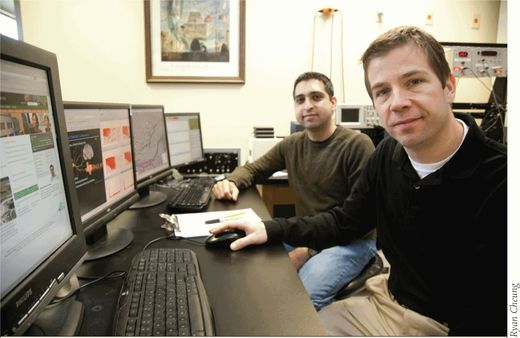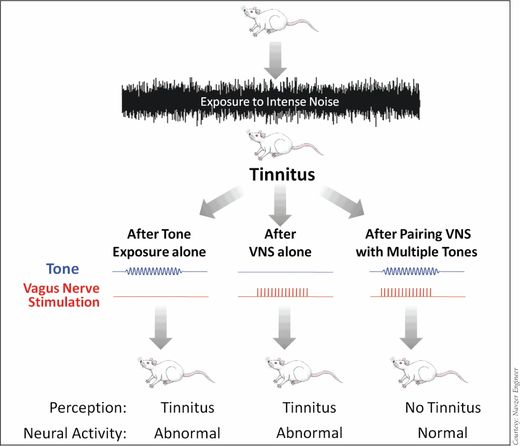
Investigators were able to use vagus nerve stimulation (VNS) to restore neural activity to normal and reverse the pathology of tinnitus in a rat model, according to a paper published online Jan. 12 before the print edition of Nature.
Based on the findings, the investigators - scientists at the University of Texas and MicroTransponder, a medical device company - are working to design a clinical trial for treating tinnitus.
"Brain changes in response to nerve damage or cochlear trauma cause irregular neural activity believed to be responsible for many types of chronic pain and tinnitus," said the senior investigator Michael Kilgard, PhD, associate professor of neuroscience at the University of Texas at Dallas.
The brain maps in the somatosensory and auditory cortex are changed in response to the noise trauma and this generates pathological neural activity thought to be responsible for the tinnitus, the study author explained, adding that the severity of the tinnitus is correlated with the degree of map reorganization.
"When we paired tones with brief pulses of VNS we eliminated the physiological and behavioral symptoms of tinnitus in noise-exposed rats," said the lead author Navzer D. Engineer, PhD, vice president of preclinical affairs at MicroTransponder and a former post-doctoral fellow in the Dr. Kilgard's laboratory. The animals were monitored for three weeks after the therapy and the changes remained constant. "Pairing sounds with VNS provides that precision by rewiring damaged circuits and reverses the abnormal activity that generates the phantom sound."

Using animals to study tinnitus is challenging. The scientists used a "gap detection model," exposing the rats to loud noise for one hour under anesthesia and then testing their ability to respond to a quiet gap, a silent interval, in a tone near the tinnitus frequency. The noise-exposed rats showed a significant impairment in their ability to do this but they had a normal response when the gap was placed in a higher or lower tone. The Texas researchers said that this frequency-specific impairment in gap detection is a sign that noise-exposed rats experience a mid-frequency tinnitus 'ringing' that fills the silent gaps.
For the study, the rats received VNS alone and VNS paired with multiple tones. The gap impairment was eliminated only in the rats that were exposed to VNS paired with the tones.
Three weeks after the therapy, the investigator studied the brains and identified an increase in the number of cells in the primary auditory cortex near the paired tone frequency, suggesting that the technique generated long-lasting changes in cortical organization. In other words, it reversed the abnormal brain changes that trigger tinnitus.
"The tinnitus was eliminated in the rats," said Dr. Engineer. They recorded the electrical activity and found that there was less excitability, less spontaneous firing of nerve cells and less synchrony. This synchrony is not a good thing because neurons fire together and most likely results in the ringing sensation.
"It seems to rewire abnormal brain circuits," he added. "Unfortunately, the brain lacks the ability to optimally repair itself after damage to the inner ear after exposure to loud sounds. The brain does not sit dormant either. Instead, these neurons generate abnormal activity that the patient perceives as a phantom sound."
The University of Texas scientists started MicroTransponder, Inc., and last year received a $1.7 million grant to study VNS as a treatment for tinnitus. The first patients will have electrodes attached to the left vagus nerve in their necks. They will return to the clinic everyday for three weeks during which time the VNS will be paired with sounds. Dr. Engineer noted that VNS has been used in over 50,000 patients for the treatment of epilepsy and depression.
Many clinicians are seeing a new wave of tinnitus among soldiers exposed to blast injuries, Dr. Navzer said. There are an estimated 10 million people with tinnitus and about two million of them have it severe enough that it impairs everyday functioning.
"This could potentially be a wonderful breakthrough," said Richard Tyler, PhD, director of audiology and otolaryngology at the University of Iowa. "There is no cure for tinnitus," which is disabling for patients, Dr. Tyler said. This study showed that the brain pathology in a model of tinnitus was reversed. It is certainly worth trying because nothing has worked to actually stop the ringing."
Dr. Tyler has developed a counseling and sound therapy program for his patients but he said that it only masks the underlying abnormality that leads to a perceptual impairment.
Alan Lockwood, MD, professor of neurology and nuclear medicine at the University of Buffalo, has conducted scanning studies on patients with tinnitus and has confirmed the observation that there is an abnormal expansion of cells in the auditory cortex that is associated with hearing loss and the ringing sounds. He said that the current study is evidence for the possibility that these abnormalities could be reversed with the technique of VNS with paired tones.
"We don't know how successful it would be unless we test it in humans. There is enough evidence that VNS is safe. Now the question is will it work for tinnitus?"
He said that however that "tone-pairing with VNS represents quite a different set of circumstances compared with VNS implanted for epilepsy or depression. Surgical implantation of a VNS is a fairly drastic measure for a condition that is usually reasonably benign (although there are exceptions). A human study would need to pair the tones with VNS. I have no experience with VNS but wonder whether units deployed are capable of delivering the stimuli paired with tones, as in the rat study."
In view of the large number of studies that have been unsuccessful in treating tinnitus, he added, "it is hard to be optimistic about any new study. From an ethical perspective, I would like to see replication of the present observation and perhaps a survey of VNS patients with tinnitus before a human implantation study."
Reference:
Engineer ND, Riley JR, Kilgard MP, et al. "Reverse pathological neural activity using targeted plasticity." Nature 2011; E-pub 2011 Jan. 12.



Comment: It is possible to safely and easily stimulate the vagus nerve through gentle breathing exercises. To learn more about Vagus Nerve Stimulation, through breathing exercises, and naturally producing the stress reducing hormone Oxytocin in the brain, visit the Éiriú Eolas Stress Control, Healing and Rejuvenation Program here.